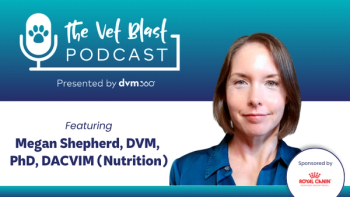
Stomatitis in dogs and cats (Proceedings)
Stomatitis in dogs is relatively uncommon however can cause significant health issues when it does occur.
Stomatitis in dogs is relatively uncommon however can cause significant health issues when it does occur. Dogs may present with anorexia, dysphagia, halitosis, oral cavity bleeding and submandibular lymphadenopathy. Candida albicans (thrush-mouth) is the main etiologic agent of stomatitis in the dog. Culture and isolation of C.albicans is needed to correctly diagnose. Treatment with antifungals are necessary for resolution. Other causes of stomatitis in the dog are gingivitis, immune-mediated (lymphocytic-plasmacytic) and a condition called "trench mouth" with the etiological agent thought to be a spirochete or fusoform bacteria and is responsive to antibiotic treatment such as ampicillin and metronidazole.
Stomatitis in the cat is a more problematic condition that is usually chronic (months to years) and can be severely debilitating. The current term for this condition in cats is "Feline Chronic Gingivo-Stomatitis (FCGS)" . Underlying causes are many with often times a cause not identified. More research is needed to identify the causes of stomatitis in cats to provide more specific and effective treatments. Known causes are gingitivits, eosinophilic granuloma, immune-mediated (lymphocytic-plasmacytic, plasmacytic), calicivirus, herpesvirus associated with FIV and FeLV positive cats, food allergy and C. albicans. Bartonella has been isolated in cats with stomatitis however the relatioinship if any to stomatitis is not known. Stomatits has also been associated with tooth root absorption in cats. Viral cause of stomatitis can be infectious and cause multiple cats in a household or cattery to become affected.
In both dogs and cats secondary causes of stomatitis are caused by metabolic disease such as uremia,diabetes mellitus, liver disease, respiratory disease and neoplasia. nutritional deficiencies and immunosuppression caused by primary problem, secondary to disease or immunosuppressive drug therapy and severe dental disease. Trauma and foreign bodies, particularly in dogs, can cause focal ulceration of the oral cavity. Electrical burns and caustic chemical agents can cause severe stomatitis in the dog and cat. Autoimmune diseases such as Pemphigus Vulgaris, Pemphigus Foliaceus and Bullous Pemphigoid can cause stomatitis along with dermatological lesions.
Oro-dental Exam of Stomatitis
Stomatitis lesions are described by the anatomical location of the lesion. Gingivitis, periodontitis, glossitis, bucco-stomatitis, faucitis, pharyngitis, lingual and palatal ulcerations. Stomatitis is often painful and causes ptyalism. The mucosal barrier of the oral cavity can be erythematous, ulcerative, hyperplastic, hemorrhagic and possibly white plaques if fungal. A detailed exam of the oral cavity and gingival often require anesthesia in a fractious, painful patient. Dental probes are used to identify periodontitis and gingivitis.
Diagnosis of Stomatitis
All patients presenting with stomatitis of unknown cause should have routine bloodwork (CBC, chemistry panel and in cats, FeLV and FIV testing) to rule out metabolic and viral causes. Oral exam as described above is the next step usually with anesthesia needed. Dental radiographs may be indicated if tooth root or alveolar bone are involved. Biopsy and culture of the "freshest" looking lesions are needed to try to definitively diagnose the cause of stomatitis. Biopsy of ulcerative lesions often only diagnose ulceration and necrosis of tissue without identifying an underlying histopathology so avoidance of biopsy of ulceration is advised. Normal bacterial and fungal flora are numerous in the oral cavity making bacterial culture and sensitivity usually useless. Although C.albicans is in the normal flora of the oral cavity, overgrowth may be diagnostic.
Treatment of Stomatitis
If a primary cause is identified such as fungal or dental disease, then specific treatments can be given such as antifungals and dental cleaning. Immune-mediated causes may respond to immunosuppressive therapy such as corticosteroids but often the response is temporary. Lymphocytis-plasmacytic stomatitis is thought to be due to chronic disease of a primary agent however at the stage most cats present, an underlying cause is often not found. Therefore treating the inflammatory response with anti-inflammatory/immunosuppressive therapy is indicated. Antibiotics reported to work in cats are clindamycin, metronidazole and tetracycline. These antibiotics control anaerobic flora. In cats the response is often short-lived. Antiviral therapy used for control of clinical signs in cats with FeLV and FIV such as interferon therapy may be successful in some patients. Bovine interferon, IFN-alpha with potentially five subtypes may improve stomatitis of viral or other causes. Laser treatment of lesions has also been successful in some patients by initiating a healing response of the ulcerated and hyperplastic lesions. Dental extraction of premolars and molars has been reported to be successful in cats suspected to have severe dental disease or immune-mediated attack of the periodontal ligament. Food allergies may be present and hypoallergenic diets may be successful. Other therapies used are mouth rinses (chlorhexadine), frequent dental exam and cleaning. Cyclosporine, an antilymphocytic drug may also be useful.
Prognosis of Stomatitis
In the dog, identification of the cause and treatment are usually successful although immune-mediated disease may be more difficult to have a response. In the cat, most often response is short-lived is a positive response occurs at all. This is a very frustrating, debilitating problem in many cats and can cause significant weight loss and poor quality of life. The cost of diagnosis and trial of many therapies can be prohibitive for some clients.
Newsletter
From exam room tips to practice management insights, get trusted veterinary news delivered straight to your inbox—subscribe to dvm360.



